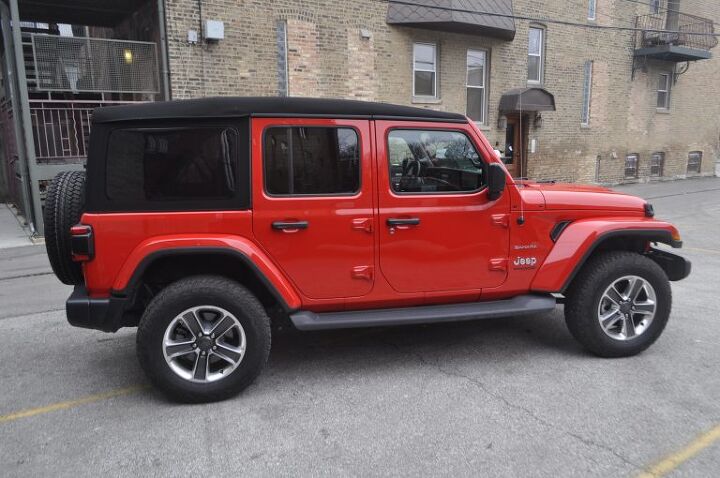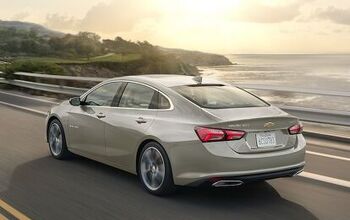2020 Jeep Wrangler Unlimited Sahara Review - Diesel Brings a Boost

2020 Jeep Wrangler Unlimited Sahara 4X4 Fast Facts
When people complain about Jeep Wranglers, it’s often to remark on how the on-road dynamics suffer in the name of off-road capability.
Jeep has come a long way in that regard, with the current Wrangler better balancing its off-road mission against the need for on-road comfort and competence. But one complaint remains: the common observation that, with either gas engine, the Wrangler could stand to gain some low-end grunt.
Enter the EcoDiesel.
The updated 3.0-liter turbo V6 oil-burner will be sold by Fiat Chrysler as a fuel-economy booster, hence the name “EcoDiesel.” And the EPA numbers aren’t bad — 22 mpg city/29 mpg highway/25 mpg combined. As for power figures, the 260 horsepower on tap are actually 10 and 25 fewer ponies that what’s available on the 2.0-liter turbo four or the 3.6-liter gas V6, respectively, but the 442 lb-ft of torque dwarfs the other two’s numbers (295 and 260).
Thing is, even if Wrangler owners are more likely to hit the dusty trail than owners of most other utility vehicles on the market, they still have to drive in urban and suburban environments. And the stoplight-to-stoplight run, along with the freeway merge, become easier with more torque on hand. Which is exactly what we have here.
I didn’t get a ton of seat time, as this Wrangler arrived at my door very early in the pandemic, before I got a sense of how much driving I could do without upsetting authorities. As the shelter-in-place rolled on, I was able to get out of the house more and put miles on loaners. But in the confusing first days of coronavirus time, I, like most, shuttered myself indoors.
Still, I got enough wheel time to sense that the shot of torque is a welcome addition to the Wrangler experience. Around-town driving is more pleasurable than before, and the power will make merging easier.
[Get new and used Jeep Wrangler pricing here!]
The only bummer is the lack of an available manual transmission with this mill, at least for now. This isn’t the standard lament – I’ve accepted manuals only really belong in sports cars, base work trucks, and certain off-roaders. Since the petrol Wrangler is available with three pedals, it seems wrong that this one isn’t. Not to mention how fun it might be to row one’s own with more torque on tap.
Otherwise, the driving experience, near as I could ascertain from a relatively low-mileage loan, is pretty standard Wrangler. Steering that needs corrections, some ride harshness, some truck-like motions; yet all of these mitigated as best can be.
Speaking of steering, FCA made tweaks to both the Wrangler and Gladiator to address complaints leveled by overfed shrimp-eaters like me. I didn’t quite notice the difference in this Wrangler – again, perhaps due to lockdown life – but I had two Gladiators (including the desert-runner Mojave) shortly after, and both behaved much better than the one I drove last summer.
The rest of the Wrangler experience is on display here, too. Same famous looks, same modernized interior. Same off-road goodies – Dana 44 heavy-duty axles are standard, front and rear, on all trims equipped with EcoDiesel, as just one example.
Those three trims are base Sport, mid-level Sahara, and top-dog Rubicon. I was given possession of a Sahara for a week, and standard features included remote keyless entry, heavy-duty suspension, skid plates for the transmission, transfer case, and fuel tank; UConnect infotainment, 7-inch infotainment screen, 7-inch TFT gauge-cluster screen, Apple CarPlay, Android Auto, and satellite radio.
Options included leather seats and interior trim bits ($1,495); heated steering wheel, front seats, and remote start ($995); LED lights, including fog lamps ($1,045); and 8.4-inch infotainment-system screen, navigation, and premium audio ($1,695). A dual-top package that allows the owner to rock both the hard and soft tops (not at the same time, mind you) ran $2,295, and a safety package including blind-spot monitoring and rear cross-traffic alert cost $895.
Another safety package added adaptive cruise control, forward-collision warning, and brake assist for $795. A storage bag for the soft top cost $75 and the transmission added $2,000, while the engine added $4,000. It also added an anti-spin rear diff and 18-inch wheels, a Dana front axle, and a 3.73 rear-axle ratio. A final $495 was tacked on for a proximity key.
With destination, that’s $55K. A bit steep, but getting all of the best – and worst – of the Wrangler experience while doing so with more power at your right foot’s call is definitely value added.
“Wrangler: Just add torque” has a nice ring to it.
[Images © 2020 Tim Healey/TTAC]

Tim Healey grew up around the auto-parts business and has always had a love for cars — his parents joke his first word was “‘Vette”. Despite this, he wanted to pursue a career in sports writing but he ended up falling semi-accidentally into the automotive-journalism industry, first at Consumer Guide Automotive and later at Web2Carz.com. He also worked as an industry analyst at Mintel Group and freelanced for About.com, CarFax, Vehix.com, High Gear Media, Torque News, FutureCar.com, Cars.com, among others, and of course Vertical Scope sites such as AutoGuide.com, Off-Road.com, and HybridCars.com. He’s an urbanite and as such, doesn’t need a daily driver, but if he had one, it would be compact, sporty, and have a manual transmission.
More by Tim Healey
Latest Car Reviews
Read moreLatest Product Reviews
Read moreRecent Comments
- Jonathan IMO the hatchback sedans like the Audi A5 Sportback, the Kia Stinger, and the already gone Buick Sportback are the answer to SUVs. The A5 and the AWD version of the Stinger being the better overall option IMO. I drive the A5, and love the depth and size of the trunk space as well as the low lift over. I've yet to find anything I need to carry that I can't, although I admit I don't carry things like drywall, building materials, etc. However, add in the fun to drive handling characteristics, there's almost no SUV that compares.
- C-b65792653 I'm starting to wonder about Elon....again!!I see a parallel with Henry Ford who was the wealthiest industrialist at one time. Henry went off on a tangent with the peace ship for WWI, Ford TriMotor, invasive social engineering, etc. Once the economy went bad, the focus fell back to cars. Elon became one of the wealthiest industrialist in the 21st century. Then he went off with the space venture, boring holes in the ground venture, "X" (formerly Twitter), etc, etc, etc. Once Tesla hit a plateau and he realized his EVs were a commodity, he too is focused on his primary money making machine. Yet, I feel Elon is over reacting. Down sizing is the nature of the beast in the auto industry; you can't get around that. But hacking the Super Charger division is like cutting off your own leg. IIRC, GM and Ford were scheduled to sign on to the exclusive Tesla charging format. That would have doubled or tripled his charging opportunity. I wonder what those at the Renaissance Center and the Glass House are thinking now. As alluded to, there's blood in the water and other charging companies will fill the void. I believe other nations have standardized EV charging (EU & China). Elon had the chance to have his charging system as the default in North America. Now, he's dropped the ball. He's lost considerable influence on what the standardized format will eventually be. Tremendous opportunity lost. 🚗🚗🚗
- Tassos I never used winter tires, and the last two decades I am driving almost only rear wheel drive cars, half of them in MI. I always bought all season tires for them, but the diff between touring and non touring flavors never came up. Does it make even the smallest bit of difference? (I will not read the lengthy article because I believe it does not).
- Lou_BC ???
- Lou_BC Mustang sedan? 4 doors? A quarterhorse?Ford nomenclature will become:F Series - Pickups Raptor - performance division Bronco - 4x4 SUV/CUVExplorer - police fleetsMustang- cars






































Comments
Join the conversation
LMAO 56 Grand for a Wrangler that looks like a $30k Wrangler - keep it, thanks.
This isn't a car review, its an options and price list.